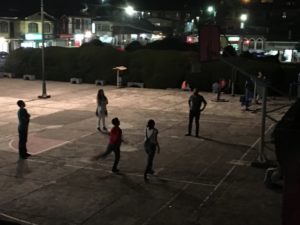A 10-year-old girl wakes up to hollering monkeys in the Costa Rican city of San Ramon. She smells the aroma of fresh coffee nearby. She readies herself for the day and heads off to school with a group of friends who have just finished a breakfast of nutritious plantains. She carries no stress for the day, just the excitement of beginning a new semester of classes.
Children and young adults in Costa Rica are advantaged with low stress and high quality of life in a country of abundance and opportunities. With an adult literacy rate more than 90%, nearly every child has the prospect of quality schooling; the Ministry of Public Education requires attendance from the age of seven or eight, and provides it free of charge.

Elementary school in the Zarcero city of Alajuelo Province, constructed during the administration of President Otilio Blanco, 1949-1953 (Jan 6, 2017).
The Costa Rican government does not permit adolescents to work until age 16 to minimize disruptions of schooling. Students have the option of attending high school for an extra year, during which time they focus on a desired field and graduate with a diploma in their specialization. The diploma promotes “college readiness and career development,” which is one value of the TAMU Grand Challenges: Enriching Our Youth initiative. An extra year and certification as a technician allows job prospects for all persons, whether they are college graduates or not. According to costarica.org, the country abolished the military in 1948 and allocated part of its funds to school systems; since then, Costa Rica has been promoting education for adolescents in various ways.
Costa Rican schools, government, and private organizations host various extracurricular activities and volunteer projects. For example, Clubes 4-S is a government organization sponsored by the Ministry of Agriculture and Cattle that organizes lectures and projects for development of Costa Rican youth. Similarly, the Comité Cantonal de la Persona Joven, or CCPJ, is an organization created by cantones, or small provinces of cities, which meets to discuss youth development in smaller towns. It also funds non-profit organizations and focuses on instilling healthier ways of life for young Costa Ricans.
In addition to education, children are also provided with quality, affordable healthcare close to home. The government provides Equipo Básico de Atención Integral en Salud, or EBAIS, which is a rural clinic for basic healthcare services in towns where hospitals are no longer functional because of overpopulation. Children are covered for vaccinations with Seguro Social, or the social security system, which promotes a “focused community approach” for the health and wellness of youth, which happens to be another mandate of the TAMU Grand Challenges: Enriching Our Youth initiative.

Zarcero city playground in Alajuela Province promotes a youth sports culture in Costa Rica (Jan 6, 2017).
Costa Rican youth are very much in touch with the “pura vida” way of life, and are gradually helping to shape the future of the country. What the Costa Rican government is promoting matches factors in the TAMU Grand Challenge: Enriching Our Youth. Costa Rica is working toward a smarter, healthier, more resourceful population of adolescents.
